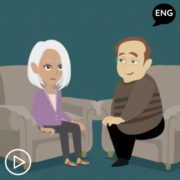How Is Diffuse Large B-Cell Lymphoma (DLBCL) Treated?
How Is Diffuse Large B-Cell Lymphoma (DLBCL) Treated? from Patient Empowerment Network on Vimeo.
How is diffuse large B-cell lymphoma (DLBCL) treated? Dr. Jean Koff shares insight about DLBCL treatment types, factors to consider in determining treatment options, reviews approaches for relapsed disease, and explains the role of clinical trials.
Dr. Jean Koff is an Assistant Professor in the Department of Hematology and Oncology at Winship Cancer Institute at Emory University. Learn more about Dr. Koff, here.
See More From The Pro-Active DLBCL Patient Toolkit
Related Programs:

|

|

|
Transcript:
Katherine Banwell:
In general, then Dr. Koff, how is DLBCL treated?
Dr. Koff:
So, in general for patients who are getting their first-line therapy, they will receive some sort of combination of chemotherapy and what we call immunotherapy. For the vast majority of patients who are young and otherwise, healthy this will be a combination chemotherapy regimen known as R-CHOP.
Which consists of three what I call conventional chemotherapy drugs, an immunotherapy called cyclophosphamide and a steroid known as prednisone.
Katherine Banwell:
What are the main factors you take into consideration before a treatment approaches decided on? You mentioned age, health.
Dr. Koff:
Yes. So, I divide it into three different categories. The first category is the patient. So, there are patient factors that determine what treatments the patient is able to tolerate. And some of the main factors you mentioned are items like age or what we call co-morbidities, which are other health problems that the patient may have. But there may be other factors as well.
If a patient is not able to take care of themselves very well, because they’re very ill or they’re very debilitated or they’re unable to receive certain treatments because they have social factors that keep them from coming to certain centers or from following-up with care. Those all fall under that patient-centered bracket.
The next factor that I consider are items related to the lymphoma itself. So, we’ve already mentioned factors like, expression of different genes or having certain gene abnormalities. Those may play a role in determining what treatment a patient gets. And then, the last big category is where the lymphoma is in the body. And this refers, generally if the lymphoma is only in one limited site. Then those patients may get fewer cycles of chemotherapy, less time in chemotherapy and may receive radiation as part of their frontline treatment.
Whereas patients who have disease in more than one site who are spread out across the body, make it more cycles of chemotherapy. But also there are patients who have lymphoma in certain sites that requires that we give additional treatment to make sure that the disease in those special sites is treated
Katherine Banwell:
Where do clinical trials fit in, Dr. Koff?
Dr. Koff:
So, our goal in treating diffuse Large B-cell lymphoma in the first-line setting in somebody who’s newly diagnosed in most patients, our goal is to cure. Meaning that we treat the patient with chemo immunotherapy. And our goal is that the lymphoma never comes back, goes away and never comes back. Unfortunately, as of today we’re not able to cure every single patient. And depending on what factors you have in your disease, your likelihood that you will be cured with that first-line therapy may be higher or lower.
But until we’re able to cure every single patient with our first-line therapy, there is definitely room for improvement. And that’s where clinical trials feature in. Because the way that we are able to tell whether new therapies or new approaches to therapies are improving upon our goal of curing or our goal of controlling the lymphoma. We need to test them very rigorously in clinical trials.
Katherine Banwell:
Of course. Now what about for patients with relapsed disease?
Dr. Koff:
So, there are several different approaches that we use to patients who have relapsed depending on a lot of different factors that may play into a particular case. I would argue that in this case, clinical trials are even more important.
Because although we can still treat with the goal of cure for a relapsed patients with DLBCL, the likelihood that somebody will be cured after they’ve received their frontline therapy goes down, regardless of the factors related to the case. And so, this is a setting where it’s even more important that we improve upon our current strategies of treatment and our current treatments that we have available in clinical trials again are the way that we move forward with this.










